
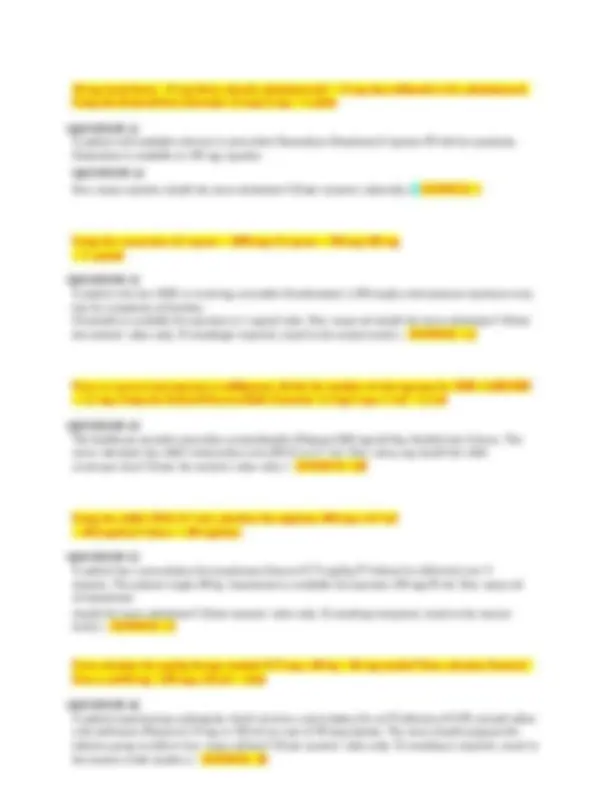
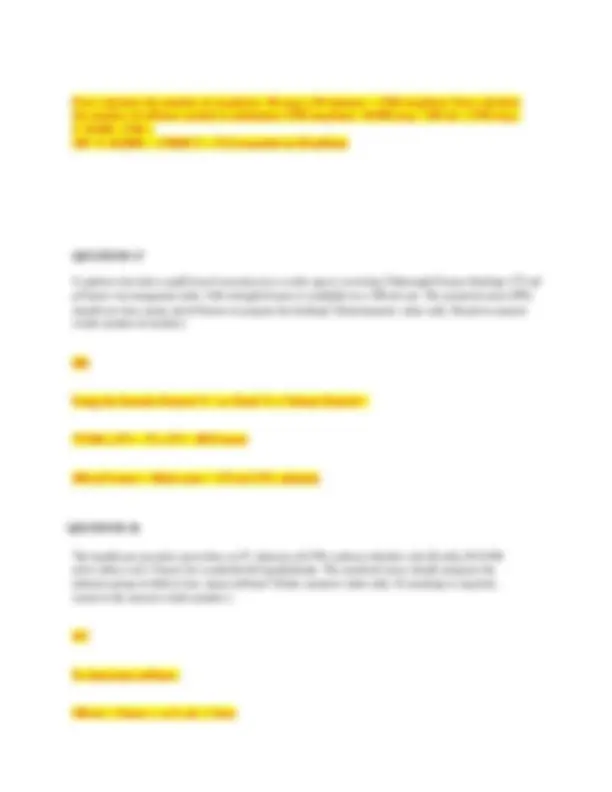
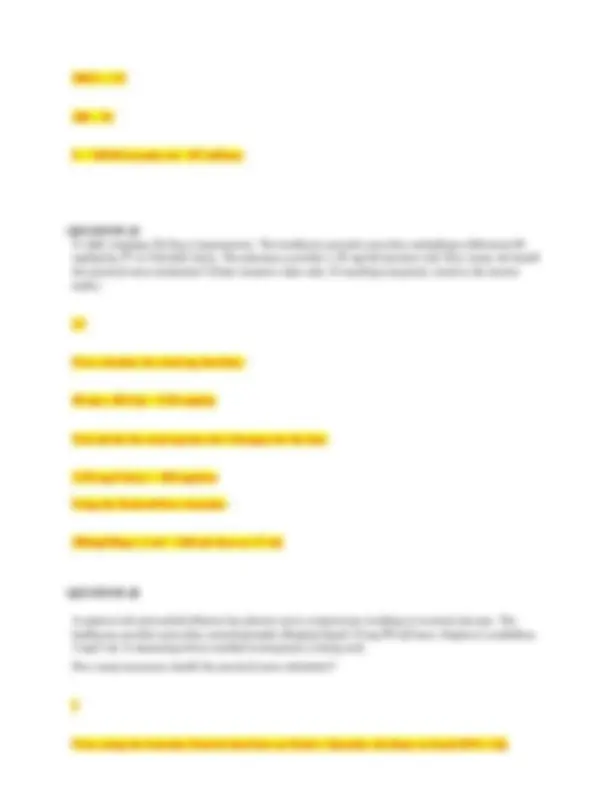
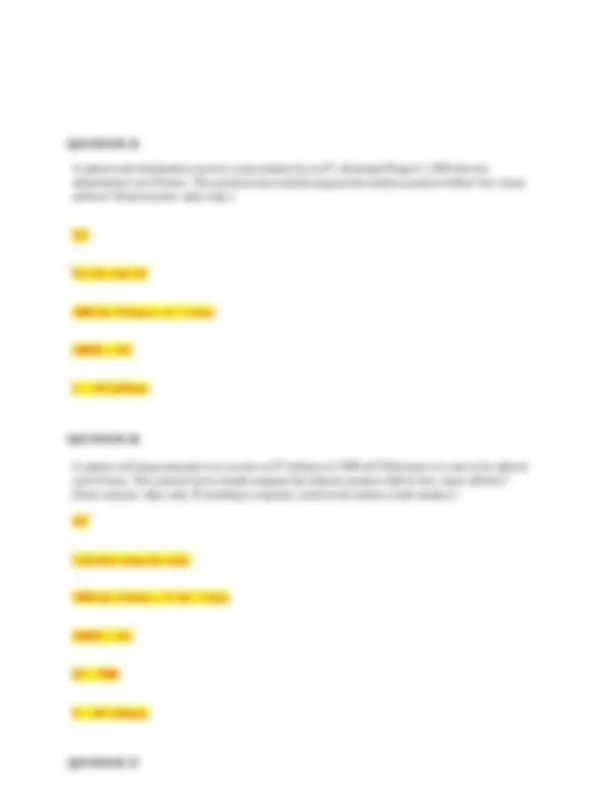
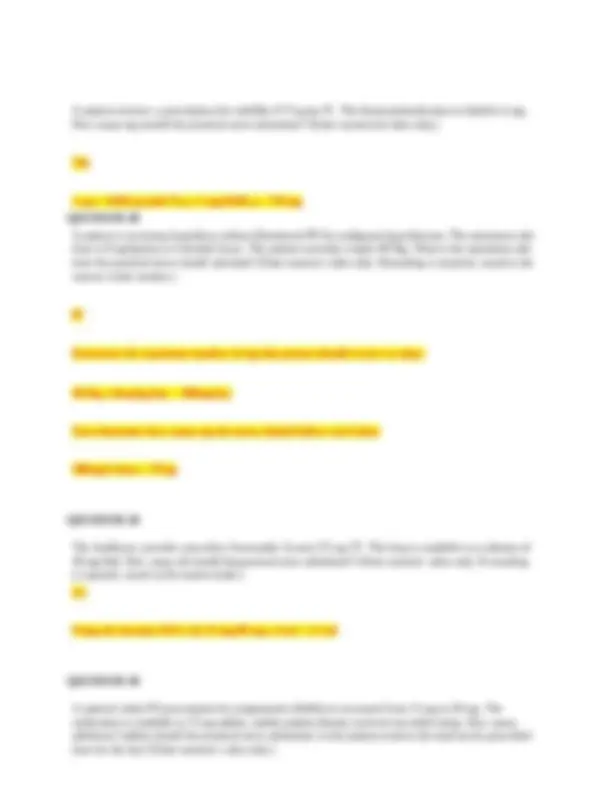
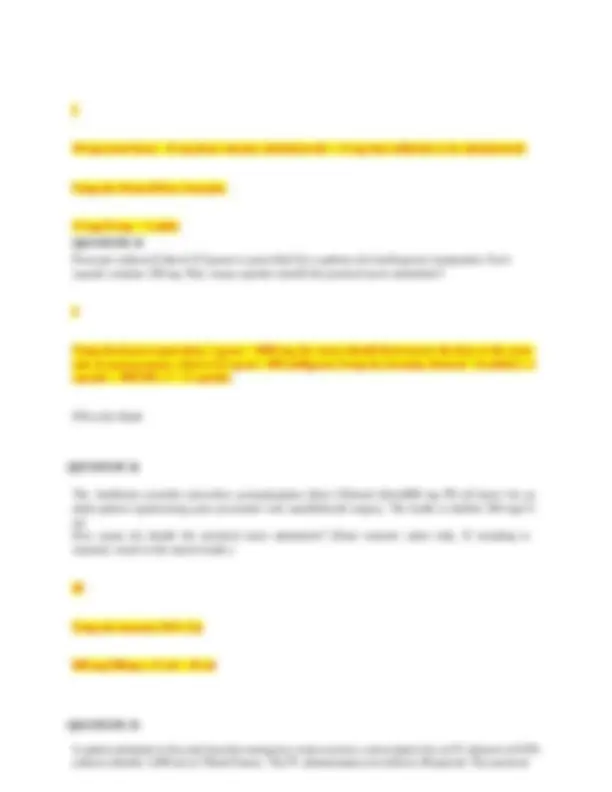
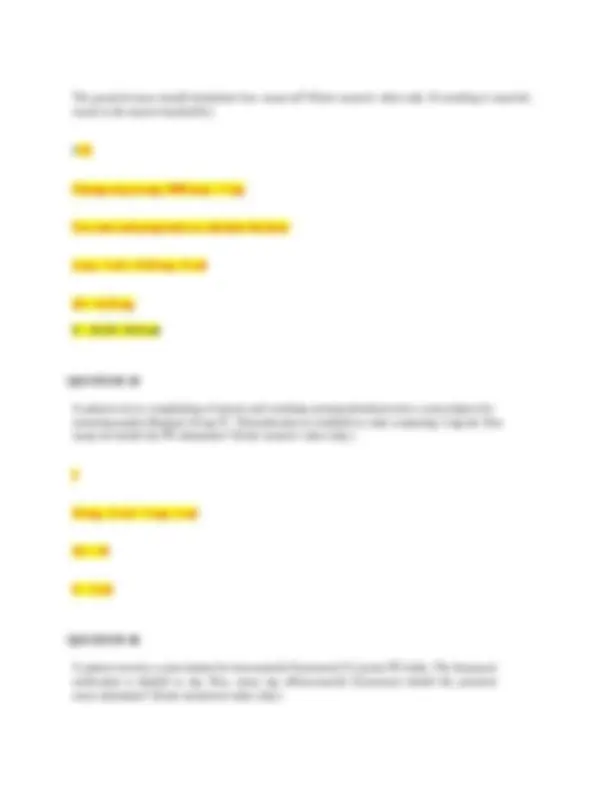
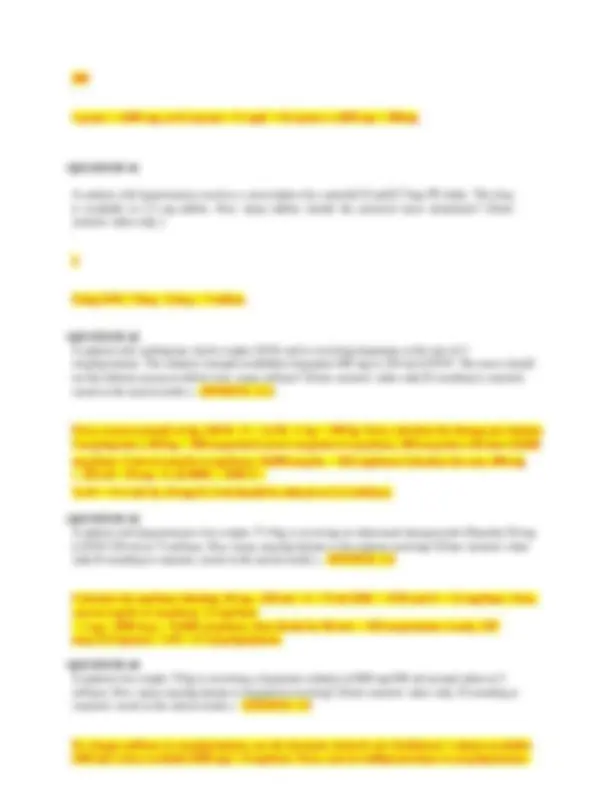
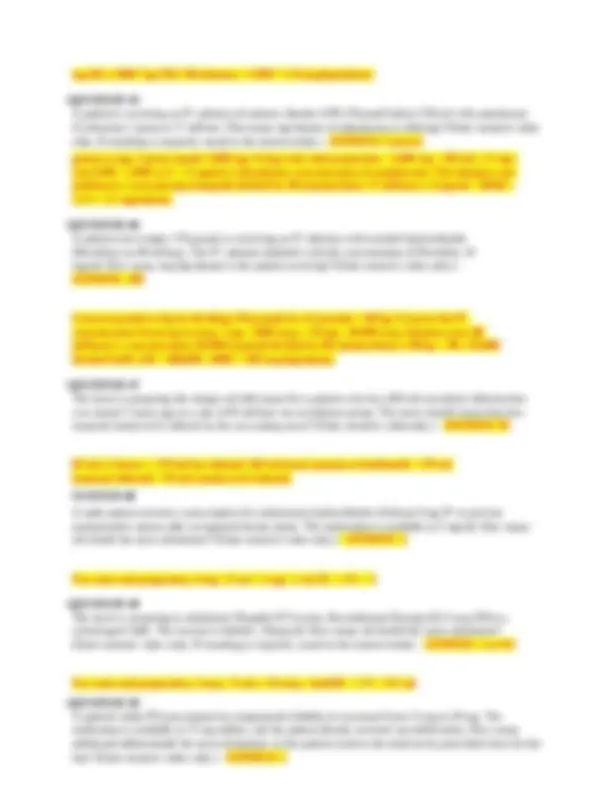
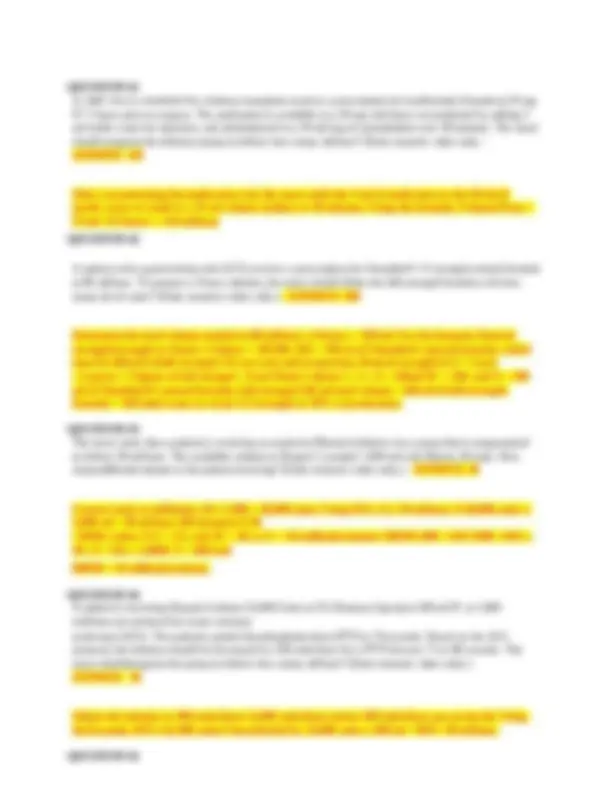
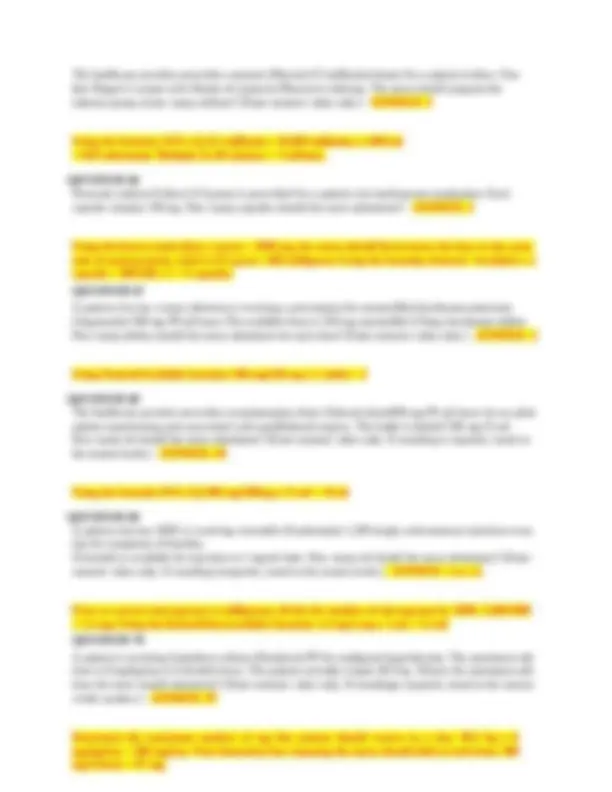
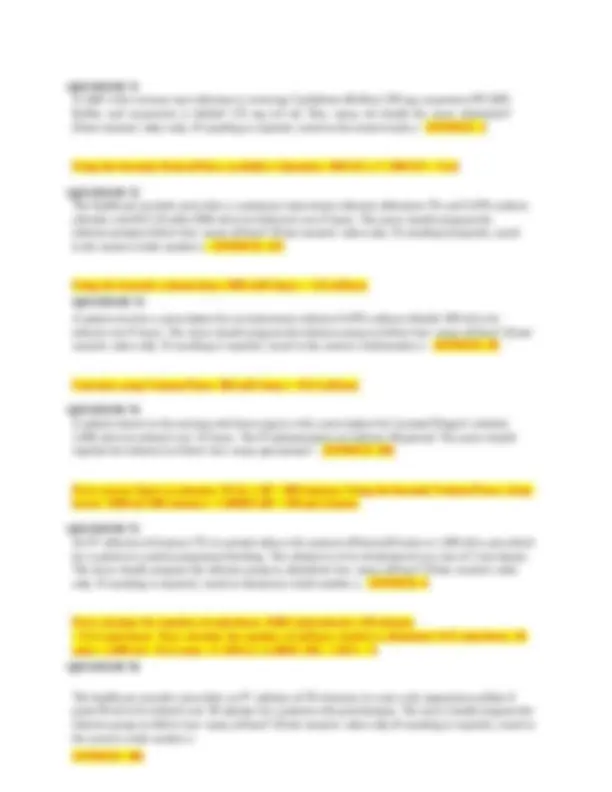
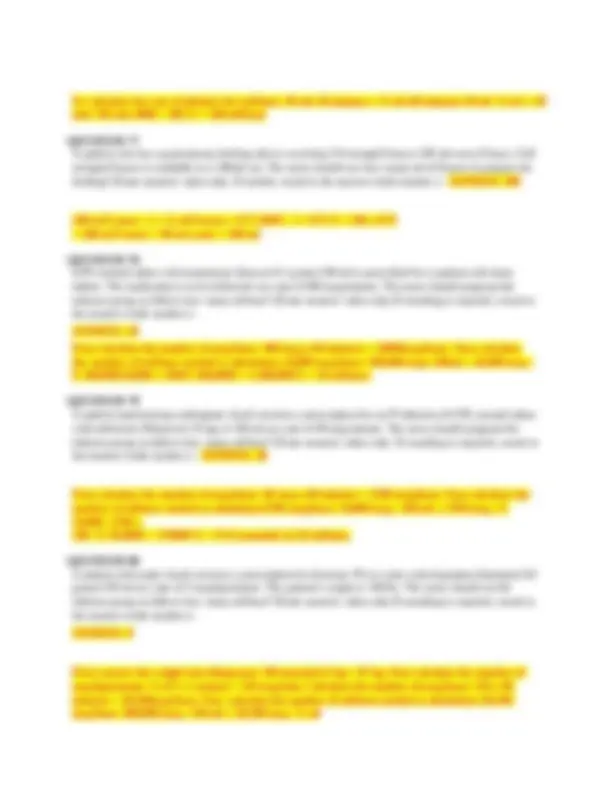
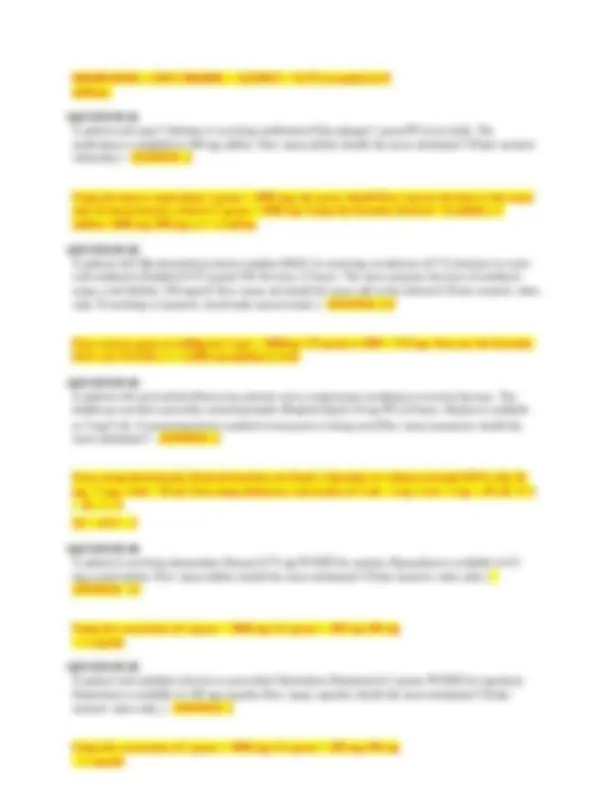
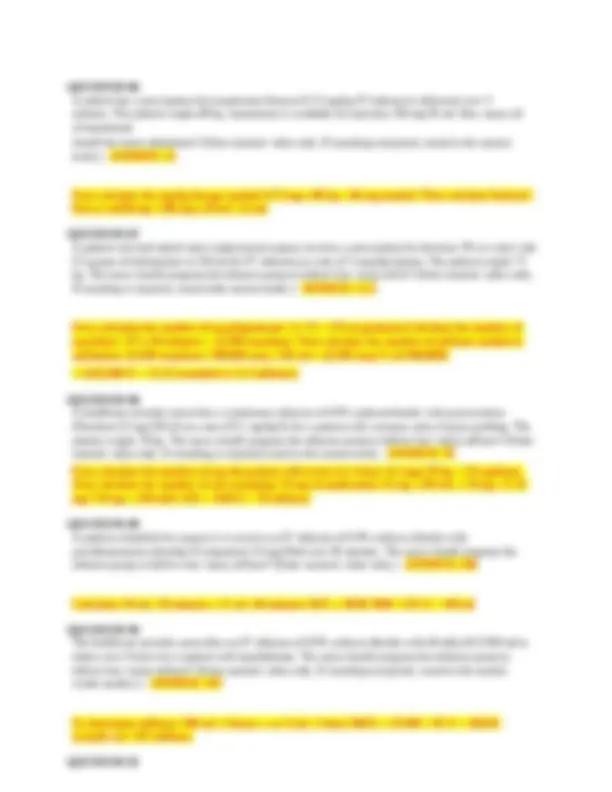
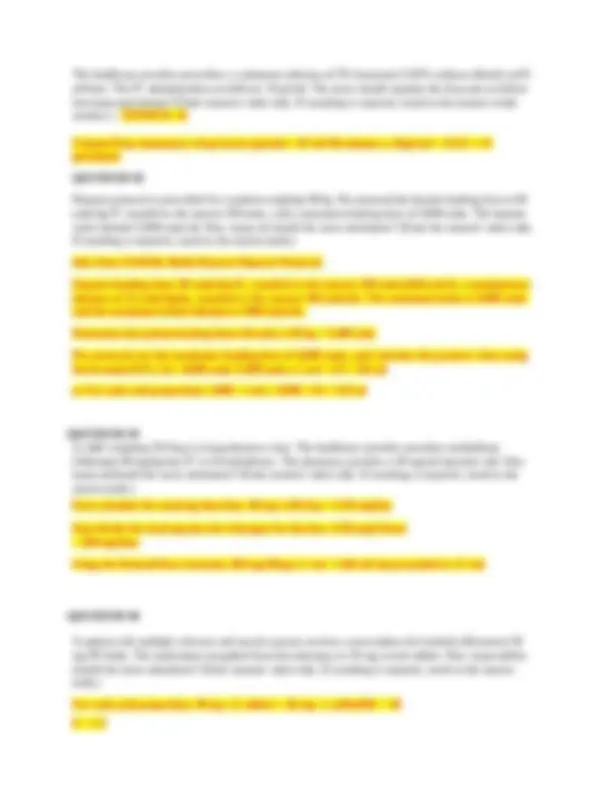
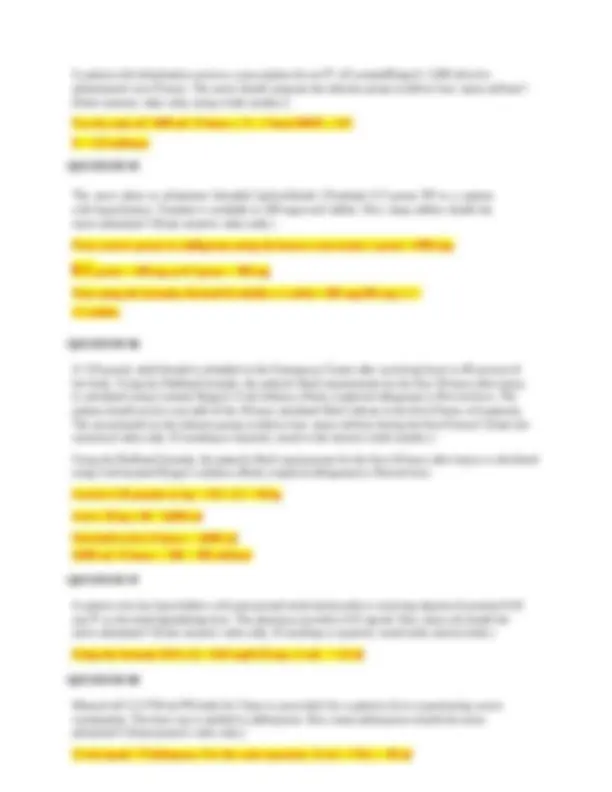
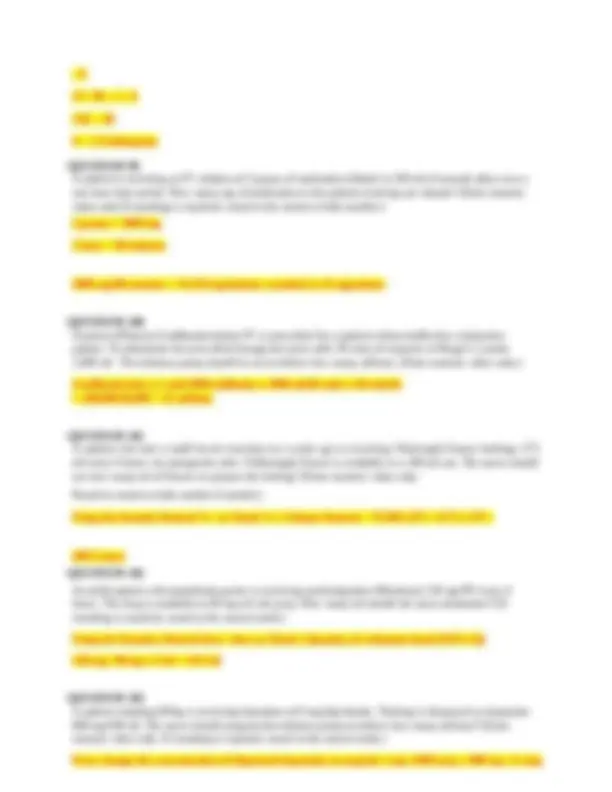
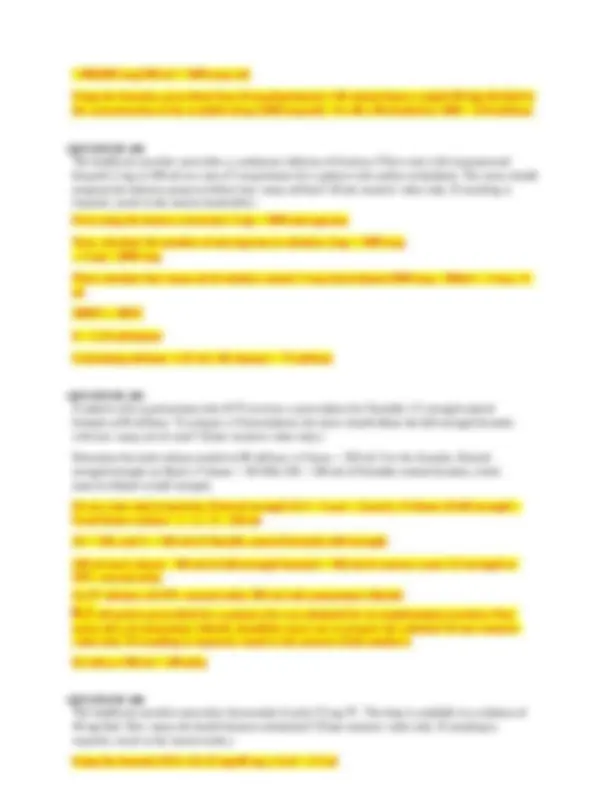
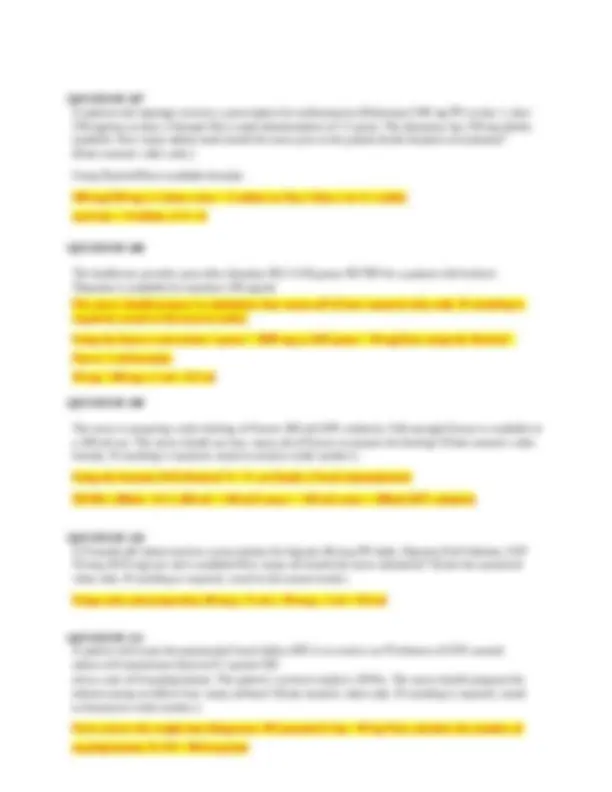
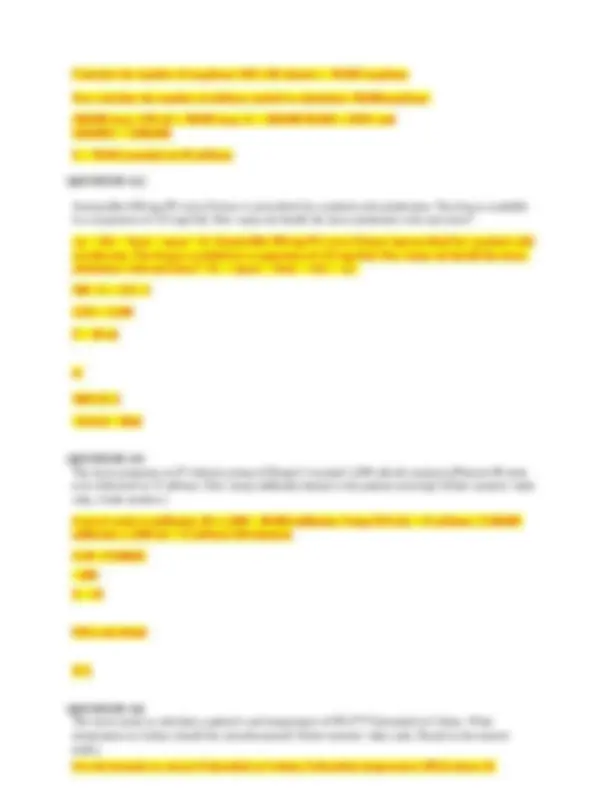
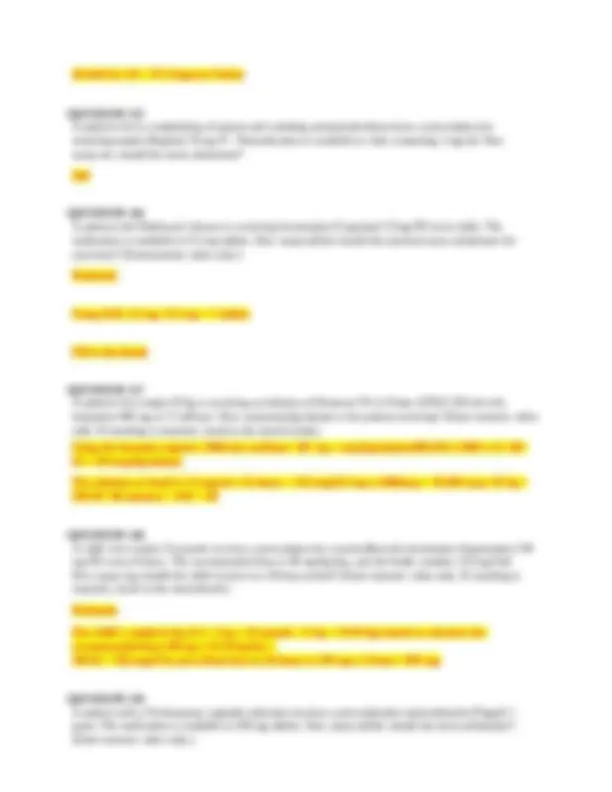

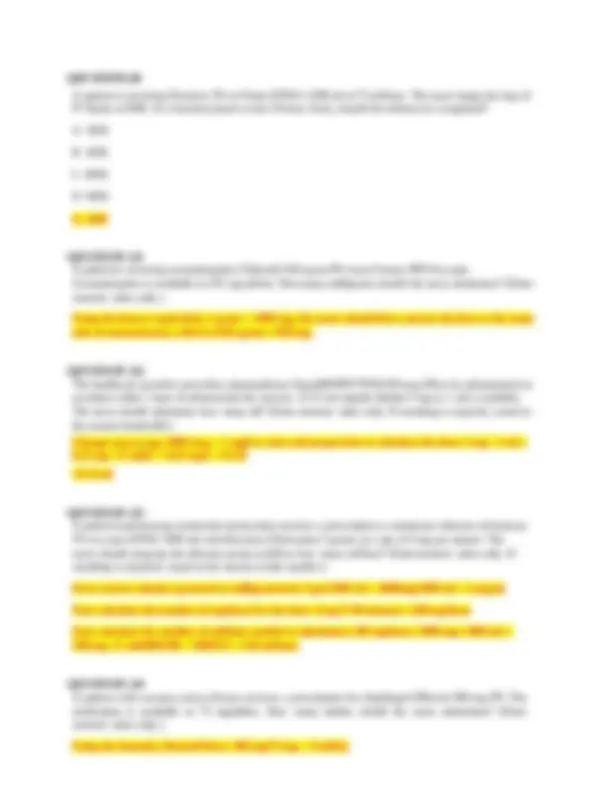
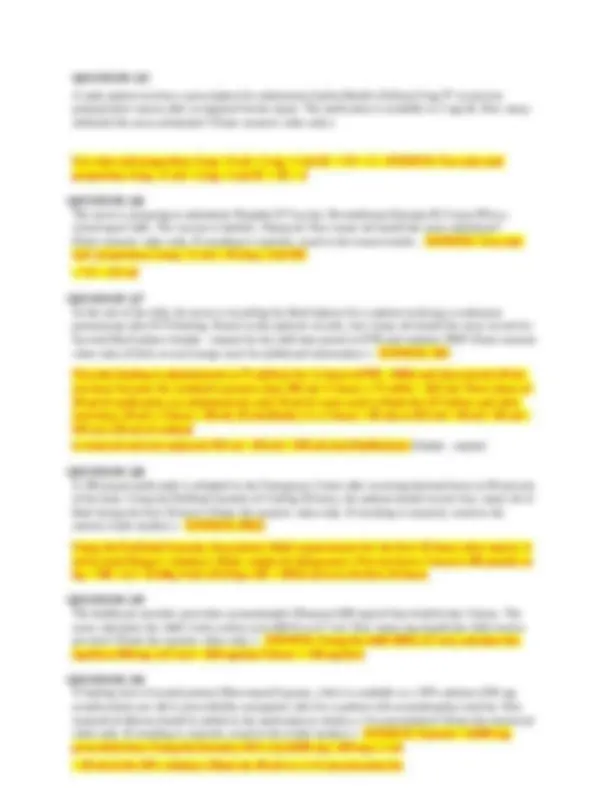
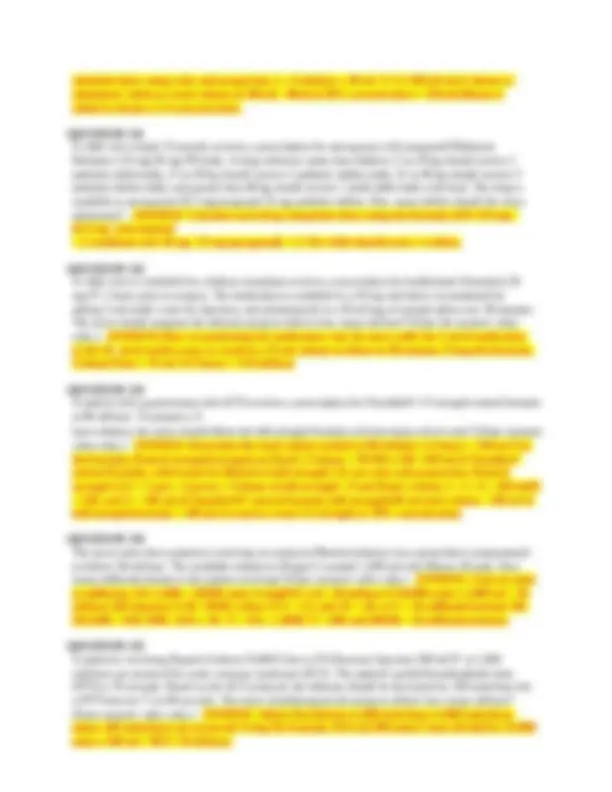

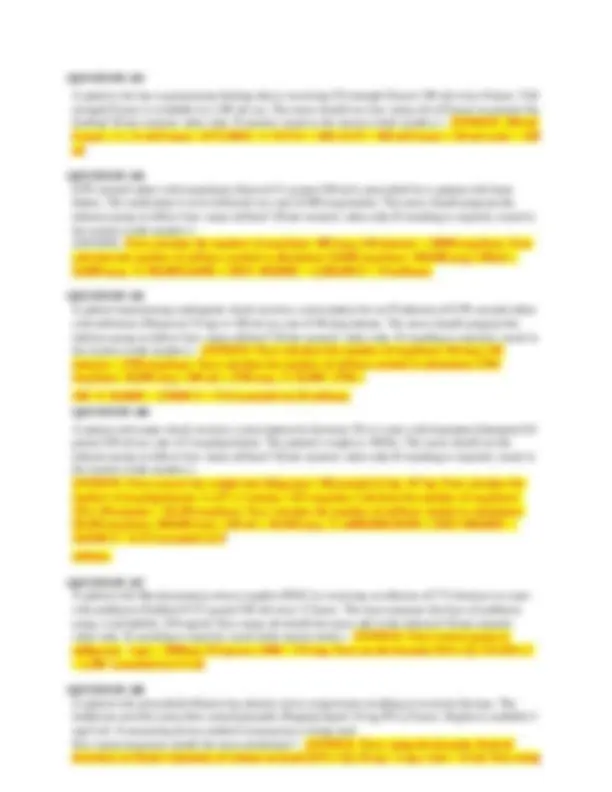
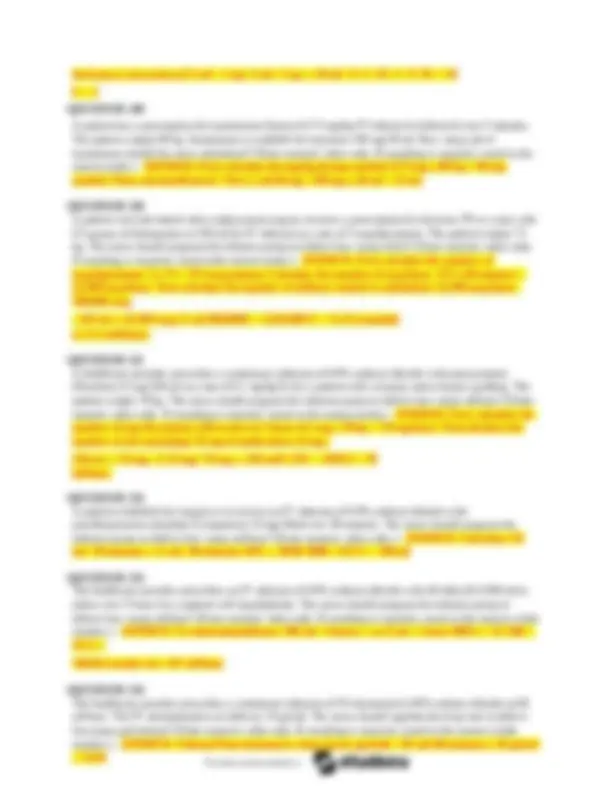



Study with the several resources on Docsity

Earn points by helping other students or get them with a premium plan


Prepare for your exams
Study with the several resources on Docsity

Earn points to download
Earn points by helping other students or get them with a premium plan
Community
Ask the community for help and clear up your study doubts
Discover the best universities in your country according to Docsity users
Free resources
Download our free guides on studying techniques, anxiety management strategies, and thesis advice from Docsity tutors
HESI DOSAGE CALCULATIONS QUIZ 150 QUESTIONS AND CORRECT SOVLED ANSWERS (2024/2025) GRADED A+
Typology: Exams
1 / 38

This page cannot be seen from the preview
Don't miss anything!































So, 18 mg/11.3 ml should be infused at 11. ml/hour.
A patient with hypertension who weighs 72.4 kg is receiving an infusionof nitroprusside (Nipride) 50 mg in D5W 250 ml at 75 ml/hour. How many mcg/kg/minute is the patient receiving? (Enter numeric value only.If rounding is required, round to the nearest tenth.) - ANSWER- 3. Calculate the mg/hour infusing, 50 mg : 250 ml = X : 75 ml 250X = 3750 and X = 15 mg/hour Next, convert mg/hr to mcg/hour, 15 mg/hour = 1 mg / 1000 mcg = 15,000 mcg/hour, then divide by 60 min = 250 mcg/minute Lastly, 250 mcg/72.4 kg/min = 3.45 = 3.5 mcg/kg/minute QUESTION 2 A patient receives a prescription for an intravenous infusion 0.45% sodium chloride 500 ml to be infused over 6 hours. The nurse should program the infusion pump to deliver how many ml/hour? (Enter numeric value only. If rounding is required, round to the nearest wholenumber.) - ANSWER- 83 Calculate using Volume/Time: 500 ml/6 hours = 83.3 ml/hour QUESTION 3 The healthcare provider prescribes a continuous intravenous infusion of dextrose 5% and 0.45% sodium chloride witth KCl 20 mEq/1000 ml to be delivered over 8 hours. The nurse should program the infusion pumpto deliver how many ml/hour? (Enter numeric value only. If rounding isrequired, round to the nearest whole number.) - ANSWER- 125 Using the formula volume/time: 1000 ml/8 hours = 125 ml/hour QUESTION 4 A patient with cardiogenic shock weighs 220 lb and is receiving dopamine at the rate of 3 mcg/kg/minute. The solution strength availableis dopamine 400 mg in 250 ml of D5W. The nurse should set the infusion pump to deliver how many ml/hour? (Enter numeric value only.If rounding is required, round to the nearest tenth.) - ANSWER- 11. First, convert pounds to kg, 220 lb : X = 2.2 lb : 1 kg = 100 kg Next, calculate the dosage per minute, 3 mcg/kg/min x 100 kg = 300 mcg/min Convert mcg/min to mcg/hour, 300 mcg/min x 60 min=18, mcg/hourConvert mcg/hr to mg/hour, 18,000 mcg/hr = 18.0 mg/hour Calculate therate, 400 mg : 250 ml = 18 mg : X ml 400X = 4500 X = 11.25 = 11.3 ml. QUESTION 5 A patient who has a sinus infection is receiving a prescription for amoxicillin/clavulanate potassium (Augmentin) 500 mg PO q8 hours.The available form is 250 mg amoxicillin/125mg clavulanate tablets. How many tablets should the nurse administer for each dose? (Enter numeric value only.) - ANSWER- 2
Using Desired/Available formula: 500 mg/250 mg x 1 tablet = 2 QUESTION 6 A child who is scheduled for a kidney transplant receives a prescription for basiliximab (Simulect) 20 mg IV 2 hours prior to surgery. The medication is available in a 20 mg vial that is reconstituted by adding 5 ml sterile water for injection, and administered in a 50 ml bag of normal saline over 30 minutes. The nurse should program the infusion pump to deliver how many ml/hour? (Enter the numeric value only.) - ANSWER- After reconstituting the medication vial, the nurse adds the 5 ml of medication to the 50 ml of sterile water to result in a 55 ml volume toinfuse in 30 minutes. Using the formula, Volume/Time = 55 ml / 0.5 hours = 110 ml/hour QUESTION 7 A patient who weighs 70 kg is receiving a dopamine solution of 800 mg/500 ml normal saline at 5 ml/hour. How many mcg/kg/minute is thepatient receiving? (Enter the numeric value only. If rounding is required,round to the nearest tenth.) - ANSWER- 1. To change ml/hour to mcg/kg/minute, use the formula: desired rate (5ml/hour) / volume available (500ml) x dose available (800mg) = 8 mg/hour. Next, convert milligrams/hour to mcg/kg/minute: mg (8) x 1000 / kg (70) / 60 minutes = 1.904 = 1.9 mcg/kg/minute. QUESTION 8 The nurse is preparing to administer Hepatitis B Vaccine, Recombinant (Energix-B) 5 mcg IM to a school-aged child. The vaccine is labeled, 10 mcg/ml. How many ml should the nurse administer? (Enter numericvalue only. If rounding is required, round to the nearest tenth). - ANSWER- 0. Use ratio and proportion, 5 mcg : X ml :: 10 mcg : 1ml 10X = 5 X = 0.5ml QUESTION 9 A patient with hypertension receives a prescription for carteolol (Cartel)7.5mg PO daily. The drug is available in 2.5 mg tablets. How many tablets should the nurse administer? (Enter numeric value only.) - ANSWER- 3 Using D/H: 7.5mg / 2.5mg = 3 tablets QUESTION 10 A patient's daily PO prescription for aripiprazole (Abilify) is increased from 15 mg to 30 mg. The medication is available in 15 mg tablets, and the patient already received one tablet today. How many additional tabletsshould the nurse administer so the patient receives the total newly prescribed dose for the day? (Enter numeric value only.) - ANSWER- 1
First calculate the number of mcg/hour: 46 mcg x 60 minutes = 2760 mcg/hour Next calculate the number of ml/hour needed to administer 2760 mcg/hour: 10,000 mcg : 100 ml :: 2760 mcg : X 10,000 / 2760 :: 100 / X 10,000X = 276000 X = 27.6 (rounded to) 28 ml/hour QUESTION 17 A patient who had a small bowel resection two weeks ago is receiving 3/4strength Ensure feedings 275 ml q4 hours via nasogastric tube. Full strength Ensure is available in a 240 ml can. The practical nurse (PN) should use how many ml of Ensure to prepare the feeding? (Enternumeric value only. Round to nearest whole number if needed.) 206 Using the formula Desired % / on Hand % x Volume Desired = 75/100 x 275 = .75 x 275 = 206 Ensure 206 ml Ensure + 69ml water = 275 ml (75% solution) QUESTION 18 The healthcare provider prescribes an IV infusion of 0.9% sodium chloride with 40 mEq KCl/ ml to infuse over 3 hours for a patientwith hypokalemia. The practical nurse should program the infusion pump to deliver how many ml/hour? (Enter numeric value only. If rounding is required, round to the nearest whole number.) 167 To determine ml/hour: 500 ml : 3 hours :: as X ml : 1 hour
X = 166.66 (rounds to)= 167 ml/hour QUESTION 19 A child weighing 28.4 kg is hypertensive. The healthcare provider prescibes methyldopa (Aldomet) 40 mg/kg/day IV in 4 divided doses. The pharmacy provides a 50 mg/ml injection vial. How many ml should the practical nurse administer? (Enter numeric value only. If rounding isrequired, round to the nearest tenth.)
First calculate the total mg dose/day: 40 mg x 28.4 kg = 1136 mg/day Next divide the total mg into the 4 dosages for the day: 1136 mg/4 doses = 284 mg/dose Using the Desired/Have formula: 284mg/50mg x 1 ml = 5.68 ml/ dose or 5.7 ml. QUESTION 20 A patient with pericardial effusion has phrenic nerve compression resulting in recurrent hiccups. The healthcare provider prescribes metoclopramide (Reglan) liquid 10 mg PO q6 hours. Reglan is availableas 5 mg/5 ml. A measuring device marked in teaspoons is being used. How many teaspoons should the practical nurse administer? 2 First, using the formula, Desired dose/dose on Hand x Quantity ofvolume on hand (D/H x Q),
1000 mg / 500 mg x 1 = 2 tablets QUESTION 23 A patient with a gastrostomy tube (GT) receives a prescription for Osmolite 1/2 strength enteral formula at 80 ml/hour. To prepare a 4 hoursolution, the PN should dilute the full-strength formula with how many ml of water? (Enter numeric value only.) 160 Determine the total volume needed at 80 ml/hour x 4 hours = 320 ml. Use the formula, Desired strength/strength on Hand x Volume = 50/ x 320 = 160 ml of Osmolite enteral formula, which must be diluted tohalf strength. Or use ratio and proportion, Desired strength (1/2 = 1 part : 2 parts) ::Volume of full strength : Total Desire volume 1 : 2 :: X : 320 ml 2X = 320, and X = 160 ml of Osmolite enteral formula, full strength 320 ml total volume - 160 ml of full-strength formula = 160 ml of waterto create 1/2 strength or 50% concentration QUESTION 24 A patient who weighs 70 pounds receives a prescription for phenytoin (Dilantin) PO. The practical nurse (PN) refers to the published drug literature which recommends the dose of 10 mg/kg/day. How many mg should the PN determine is the recommended dose for this patient? (Enternumerical value only. If rounding is required, round to the nearest wholenumber.) 318 2.2 pounds = 1 kg, so 70 pounds = 31.8181 kg31.8181 x 10 mg/1 kg/day = 318.181 or 318 mg/day
A patient with dehydration receives a prescription for an IV of lactated Ringer's 1,000 ml to be administered over 8 hours. The practical nurse should program the infusion pump to deliver how many ml/hour? (Enternumeric value only.) 125 Use the ratio of: 1000 ml : 8 hours :: X : 1 hour 1000/X :: 8/ X = 125 ml/hour QUESTION 26 A patient with hypernatremia is to receive an IV infusion of 1000 ml 5%dextrose in water to be infused over 6 hours. The practical nurse should program the infusion pump to deliver how many ml/hour? (Enter numeric value only. If rounding is required, round to the nearest whole number.) 167 Calculate using the ratio: 1000 ml : 6 hours :: X ml : 1 hour 1000/X :: 6/ 6X = 1000 X = 167 ml/hour QUESTION 27
30 mg (total dose) - 15 mg (dose already administered) = 15 mg that stillneeds to be administered. Using the Desired/Have formula: 15 mg/15 mg = 1 tablet QUESTION 31 Docusate sodium (Colace) 0.3 grams is prescribed for a patient who hasfrequent constipation. Each capsule contains 100 mg. How many capsules should the practical nurse administer? 3 Using the known equivalent, 1 gram = 1000 mg, the nurse should firstconvert the dose to the same unit of measurement, which is 0.3 gram =300 milligram. Using the formula, Desired / Available x 1 capsule = 300/100 x 1 = 3 capsules. Fill in the blank QUESTION 32 The healthcare provider prescribes acetaminophen elixir (Tylenol elixir)600 mg PO q6 hours for an adult patient experiencing pain associated with maxillofacial surgery. The bottle is labeled 500 mg/ ml. How many ml should the practical nurse administer? (Enter numeric value only. If rounding is required, round to the nearest tenth.) 18 Using the formula D/H x Q: 600 mg/500mg x 15 ml = 18 ml QUESTION 33 A patient admitted to the unit from the emergency room receives a prescription for an IV infusion of 0.9% sodium chloride 1,000 ml at 750ml/4 hours. The IV administration set delivers 60 gtts/ml. The practical
nurse should program the infusion pump to deliver how many gtts/minute? (Enter numeric value only. If rounding is required, round tothe nearest whole number.) 188 First convert hours to minutes: 4 hours x 60 = 240 minutes Using formula Volume/Time x gtt factor: 750 ml/240 min = 3.125 x 60gtts = 187.5 (rounding to) 188 gtts/minute QUESTION 34 A healthcare provider prescribes a continuous infusion of 0.9% sodiumchloride with pancuronium (Pavulon) 25 mg/250 ml at a rate of 0.1 mg/kg/hr for a patient with coronary artery bypass grafting. The patient weighs 78 kg. The practical nurse should program the infusion pump todeliver how many ml/hour? (Enter numeric value only. If rounding is required, round to the nearest tenth.) 78 First calculate the number of mg the patient will receive in 1 hour: 0.1 mg x 78 kg = 7.8 mg/hour Next calculate the number of ml containing 7.8 mg of medication: 25 mg : 250 ml :: 7.8 mg : X 25 mg/ 7.8 mg :: 250 ml/X 25X = 1950 X = 78 ml/hour Fill in the blank
The practical nurse should administer how many ml? (Enter numeric value only. If rounding is required, round to the nearest hundredth.)
Change mcg to mg, 1000 mcg = 1 mg Use ratio and proportion to calculate the dose: 2 mg : 1 ml :: 0.25 mg : X ml 2X = 0.25 mg X = 0.125 =0.13 ml QUESTION 39 A patient who is complaining of nausea and vomiting postoperativelyreceives a prescription for metoclopramide (Reglan) 10 mg IV. Themedication is available in vials containing 5 mg/ml. How many ml should the PN administer? (Enter numeric value only.) 2 10 mg : X ml = 5 mg : 1 ml 5X = 10 X = 2 ml QUESTION 40 A patient receives a prescription for itraconazole (Sporanox) 0.2 grams PO daily. The dispensed medication is labeled in mg. How many mg ofitraconazole (Sporanox) should the practical nurse administer? (Enter numerical value only.)
1 gram = 1,000 mg, so 0.2 grams = X mgX = 0.2 gram x 1,000 mg = 200mg QUESTION 41 A patient with hypertension receives a prescription for carteolol (Cartel)7.5mg PO daily. The drug is available in 2.5 mg tablets. How many tablets should the practical nurse administer? (Enter numeric value only.) 3 Using D/H: 7.5mg / 2.5mg = 3 tablets QUESTION 42 A patient with cardiogenic shock weighs 220 lb and is receiving dopamine at the rate of 3 mcg/kg/minute. The solution strength availableis dopamine 400 mg in 250 ml of D5W. The nurse should set the infusion pump to deliver how many ml/hour? (Enter numeric value only.If rounding is required, round to the nearest tenth.) - ANSWER- 11. First, convert pounds to kg, 220 lb : X = 2.2 lb : 1 kg = 100 kg. Next, calculate the dosage per minute, 3 mcg/kg/min x 100 kg = 300 mcg/min.Convert mcg/min to mcg/hour, 300 mcg/min x 60 min=18, mcg/hour. Convert mcg/hr to mg/hour, 18,000 mcg/hr = 18.0 mg/hour.Calculate the rate, 400 mg : 250 ml = 18 mg : X ml 400X = 4500 X = 11.25 = 11.3 ml. So, 18 mg/11.3 ml should be infused at 11.3 ml/hour. QUESTION 43 A patient with hypertension who weighs 72.4 kg is receiving an infusionof nitroprusside (Nipride) 50 mg in D5W 250 ml at 75 ml/hour. How many mcg/kg/minute is the patient receiving? (Enter numeric value only.If rounding is required, round to the nearest tenth.) - ANSWER- 3. Calculate the mg/hour infusing, 50 mg : 250 ml = X : 75 ml 250X = 3750 and X = 15 mg/hour. Next, convert mg/hr to mcg/hour, 15 mg/hour = 1 mg / 1000 mcg = 15,000 mcg/hour, then divide by 60 min = 250 mcg/minute. Lastly, 250 mcg/72.4 kg/min = 3.45 = 3.5 mcg/kg/minute. QUESTION 44 A patient who weighs 70 kg is receiving a dopamine solution of 800 mg/500 ml normal saline at 5 ml/hour. How many mcg/kg/minute is thepatient receiving? (Enter numeric value only. If rounding is required, round to the nearest tenth.) - ANSWER- 1. To change ml/hour to mcg/kg/minute, use the formula: desired rate (5ml/hour) / volume available (500 ml) x dose available (800 mg) = 8 mg/hour. Next, convert milligrams/hour to mcg/kg/minute:
30 mg (total dose) - 15 mg (dose already administered) = 15 mg that stillneeds to be administered. Using the Desired/Have formula: 15 mg/15 mg = 1 tablet QUESTION 51 At the end of the shift, the nurse is recording the fluid balance for a patient receiving a continuous gastrostomy tube (GT) feeding. Based on the patient's records, how many ml should the nurse record for the total fluid balance (intake - output) for the shift that started at 0700 and endedat 1900? (Enter numeric value only.) (Click on each image asset for additional information.) - ANSWER- 695 The tube feeding is administered at 75 ml/hour for 11 hours (0700 - 1800) and then turned off for one hour because the residual is greater than 200 ml. 11 hours x 75 ml/hr = 825 ml. Three doses of 20 ml of medication are administered, with 10 ml of water used to flush the GT before and after each dose. 20 ml x 3 doses = 60 ml; 10 ml (flush) x 2 x 3 doses = 60 ml; so 825 ml + 60 ml + 60 ml = 945 ml. 250 ml of residualis removed and not replaced. 945 ml - 250 ml = 695 ml total fluid balance (Intake - output). QUESTION 52 The nurse is administering a 250 milliliter (ml) intravenous solution to be infused over 2 hours. How many ml/hour should the nurse programthe infusion pump? (Enter numeric value only.) - ANSWER- 125 250 ml : 2 hours = X ml : 1 hour 250 = 2X X = 250 divided by 2 = 125ml/hr QUESTION 53 The nurse is preparing to administer 0.25 mg of bumetanide (Bumex) IV.The medication is available in a vial labeled 1 mg/4 ml. How many ml of medication should the nurse administer? (Enter numeric value only.) -ANSWER- 1 Using the Desired/Have x Volume formula: Desired = 0.25 mg Have = 1mg Volume = 4 ml 0.25 mg/ mg x 4 ml = 1 ml QUESTION 54 A patient with hypertension receives a prescription for carteolol (Cartel) 7.5 mg PO daily. The drug is available in 2.5 mg tablets. How manytablets should the nurse administer? (Enter numeric value only.) - ANSWER- 3 Using D/H: 7.5 mg / 2.5 mg = 3 tablets QUESTION 55 The healthcare provider prescribes trimethoprim-sulfamethoxazole (Bactrim-DS Oral Suspension) 120 mg BID for a child with bronchitis. The Bactrim bottle is labeled 200 mg/5ml. How many ml should the nurse administer at each dose? (Enter numeric value only.) - ANSWER- Using the formula D/H x Q, 120/200 x 5 = 3 ml QUESTION 56 A 180-pound adult male is admitted to the Emergency Center after receiving thermal burns to 60 percent of his body. Using the Parkland formula of 4 ml/kg/24 hours, the patient should receive how many ml of
fluid during the first 24 hours? (Enter numeric value only. If rounding isrequired, round to the nearest whole number.) - ANSWER- 19632 Using the Parkland formula, the patient's fluid requirements for the first24 hours after injury: 4 ml lactated Ringer's solution x Body weight (in ilograms) x Percent burn. Convert 180 pounds to kg = 180 / 2.2 = 81.8kg 4 ml x 81.8 kg x 60 = 19632 ml over the first 24 hours. QUESTION 57 The healthcare provider prescribes acetazolamide (Diamox) 600 mg/m2/day divided into 3 doses. The nurse calculates the child's bodysurface area (BSA) as 0.7 m2. How many mg should the child receiveper dose? (Enter numeric value only.) - ANSWER- 140 Using the child's BSA, 0.7 m2, calculate the mg/dose, 600 mg x 0.7 m = 420 mg/day/3 doses = 140 mg/dose QUESTION 58 A loading dose of acetylcysteine (Mucomyst) 8 grams, which is available as a 20% solution (200 mg acetylcysteine per ml) is prescribedby nasogastric tube for a patient with acetaminophen toxicity. How manyml of diluent should be added to the medication to obtain a 1:4 concentration? (Enter numeric value only. If rounding is required, roundto the nearest whole number.) - ANSWER- 120 8 grams = 8,000 mg prescribed dose. Using the formula, D/H x Q, 8,000mg / 200 mg x 1 ml = 40 ml of the 20% solution. Dilute the 40 ml to a 1:4 concentration for administration using ratio and proportion, 1 : 4 solution :: 40 ml : X X= 160 ml total volume to administer. Subtract total volume of 160 ml - 40 ml of 20% concentration = 120 ml diluent isadded to obtain a 1: concentration. QUESTION 59 A child who weighs 55 pounds receives a prescription for atovaquone with proguanil (Malarone Pediatric) 125 mg/50 mg PO daily. A drug reference states that children 11 to 20 kg should receive 1 pediatric tablet daily; 21 to 30 kg should receive 2 pediatric tablets daily; 31 to 40 kgshould receive 3 pediatric tablets daily; and greater than 40 kg shouldreceive 1 adult tablet daily with food. The drug is available as atovaquone 62.5 mg/proguanil 25 mg pediatric tablets. How many tablets should the nurse administer? - ANSWER- 2 Calculate each drug component dose, using the formula, D/H 125 mg / 62.5 mg (atovaquone) = 2 combined with 50 mg / 25 mg (proguanil) = 2.The child should receive 2 tablets. QUESTION 60 A patient receives a prescription for azithromycin (Zithromax) 500 mg PO x 3 days. Azithromycin is available as 250 mg scored tablets. How many tablets should the nurse administer per dose? (Enter numeric valueonly. - ANSWER- 2 Using the formula, D/H 500 mg/250 mg = 2 tablets
The healthcare provider prescribes oxytocin (Pitocin) 0.5 milliunits/minute for a patient in labor. One liter Ringer's Lactate with 10units of oxytocin (Pitocin) is infusing. The nurse should program the infusion pump at how many ml/hour? (Enter numeric value only.) - ANSWER- 3 Using the formula, D/H x Q, 0.5 milliunits / 10,000 milliunits x 1000 ml = 0.05 ml/minute. Multiply by 60 minutes = 3 ml/hour. QUESTION 66 Docusate sodium (Colace) 0.3 grams is prescribed for a patient who hasfrequent constipation. Each capsule contains 100 mg. How many capsules should the nurse administer? - ANSWER- 3 Using the known equivalent, 1 gram = 1000 mg, the nurse should firstconvert the dose to the same unit of measurement, which is 0.3 gram =300 milligram. Using the formula, Desired / Available x 1 capsule = 300/100 x 1 = 3 capsules. QUESTION 67 A patient who has a sinus infection is receiving a prescription for amoxicillin/clavulanate potassium (Augmentin) 500 mg PO q8 hours.The available form is 250 mg amoxicillin/125mg clavulanate tablets. How many tablets should the nurse administer for each dose? (Enter numeric value only.) - ANSWER- 2 Using Desired/Available formula: 500 mg/250 mg x 1 tablet = 2 QUESTION 68 The healthcare provider prescribes acetaminophen elixir (Tylenol elixir)600 mg PO q6 hours for an adult patient experiencing pain associated with maxillofacial surgery. The bottle is labeled 500 mg/15 ml. How many ml should the nurse administer? (Enter numeric value only. If rounding is required, round to the nearest tenth.) - ANSWER- 18 Using the formula D/H x Q: 600 mg/500mg x 15 ml = 18 ml QUESTION 69 A patient who has AIDS is receiving octreotide (Sandostatin) 1,200 mcgby subcutaneous injection every day for symptoms of diarrhea. Octreotide is available for injection in 1 mg/ml vials. How many ml should the nurse administer? (Enter numeric value only. If rounding isrequired, round to the nearest tenth.) - ANSWER- 1 or 1. First, to convert micrograms to milligrams, divide the number of micrograms by 1000: 1,200/ = 1.2 mg. Using the Desired/Haveavailable formula: 1.2 mg/1 mg x 1 ml = 1.2 ml. QUESTION 70 A patient is receiving dantrolene sodium (Dantrium) PO for malignant hyperthermia. The maximum safe dose is 8 mg/kg/day in 4 divided doses. The patient currently weighs 48.5 kg. What is the maximum safe dose the nurse should administer? (Enter numeric value only. If roundingis required, round to the nearest whole number.) - ANSWER- 97 Determine the maximum number of mg this patient should receive in a day: 48.5 kg x 8 mg/kg/day = 388 mg/day. Next determine how manymg the nurse should deliver each dose: 388 mg/4 doses = 97 mg.
A child with a urinary tract infection is receiving Cephalexin (Keflex) 100 mg suspension PO QID. Keflex oral suspension is labeled 125 mg in5 ml. How many ml should the nurse administer? (Enter numeric value only. If rounding is required, round to the nearest tenth.) - ANSWER- 4 Using the formula Desired/Have available x Quantity: 100/125 x 5 =500/125 = 4 ml QUESTION 72 The healthcare provider prescribes a continuous intravenous infusion ofdextrose 5% and 0.45% sodium chloride with KCl 20 mEq/1000 ml to be delivered over 8 hours. The nurse should program the infusion pumpto deliver how many ml/hour? (Enter numeric value only. If rounding isrequired, round to the nearest whole number.) - ANSWER- 125 Using the formula volume/time: 1000 ml/8 hours = 125 ml/hour QUESTION 73 A patient receives a prescription for an intravenous infusion 0.45% sodium chloride 500 ml to be infused over 6 hours. The nurse should program the infusion pump to deliver how many ml/hour? (Enter numeric value only. If rounding is required, round to the nearest wholenumber.) - ANSWER- 83 Calculate using Volume/Time: 500 ml/6 hours = 83.3 ml/hour QUESTION 74 A patient returns to the nursing unit from surgery with a prescription for Lactated Ringer's solution 1,000 ml to be infused over 10 hours. The IVadministration set delivers 60 gtts/ml. The nurse should regulate the infusion to deliver how many gtts/minute? - ANSWER- 100 First convert hours to minutes: 10 hrs x 60 = 600 minutes. Using the formula Volume/Time x drop factor: 1000 ml /600 minutes = 1.66666 x60 = 100 gtts minute. QUESTION 75 An IV infusion of dextrose 5% in normal saline with oxytocin (Pitocin)20 units in 1,000 ml is prescribed for a patient to control postpartum bleeding. The solution is to be administered at a rate of 2 mu/minute. The nurse should program the infusion pump to administer how many ml/hour? (Enter numeric value only. If rounding is required, round to thenearest whole number.) - ANSWER- 6 First calculate the number of units/hour. 0.002 units/minute x 60 minutes = 0.12 units/hour. Next calculate the number of ml/hour needed to administer 0.12 units/hour. 20 units : 1,000 ml :: 0.12 units : X 20/0.12 ::1,000/X 20X : 120 X = 6 QUESTION 76 The healthcare provider prescribes an IV solution of 5% dextrose in water with magnesium sulfate 4 gram/50 ml to be infused over 30 minutes for a patient with preeclampsia. The nurse should program the infusion pump to deliver how many ml/hour? (Enter numeric value only.If rounding is required, round to the nearest whole number.) - ANSWER- 100